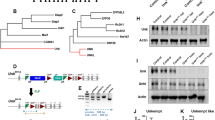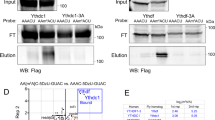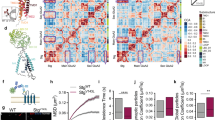Abstract
The tumour-suppressor gene Neurofibromatosis 1 (Nf1) encodes a Ras-specific GTPase activating protein (Ras-GAP)1,2,3,4,5. In addition to being involved in tumour formation6,7, NF1 has been reported to cause learning defects in humans8,9,10 and Nf1 knockout mice11. However, it remains to be determined whether the observed learning defect is secondary to abnormal development. The Drosophila NF1 protein is highly conserved, showing 60% identity of its 2,803 amino acids with human NF1 (ref. 12). Previous studies have suggested that Drosophila NF1 acts not only as a Ras-GAP but also as a possible regulator of the cAMP pathway that involves the rutabaga (rut)-encoded adenylyl cyclase13. Because rut was isolated as a learning and short-term memory mutant14,15, we have pursued the hypothesis that NF1 may affect learning through its control of the Rut-adenylyl cyclase/cAMP pathway. Here we show that NF1 affects learning and short-term memory independently of its developmental effects. We show that G-protein-activated adenylyl cyclase activity consists of NF1-independent and NF1-dependent components, and that the mechanism of the NF1-dependent activation of the Rut-adenylyl cyclase pathway is essential for mediating Drosophila learning and memory.
This is a preview of subscription content, access via your institution
Access options
Subscribe to this journal
Receive 51 print issues and online access
$199.00 per year
only $3.90 per issue
Buy this article
- Purchase on Springer Link
- Instant access to full article PDF
Prices may be subject to local taxes which are calculated during checkout



Similar content being viewed by others
References
Ballester, R. et al. The NF1 locus encodes a protein functionally related to mammalian GAP and yeast IRA proteins. Cell 63, 851 –859 (1990).
Bernards, A. Neurofibromatosis type 1 and Ras-mediated signaling: filling in the GAPs. Biochim. Biophys. Acta 1242, 43– 59 (1995).
Huson, S. M., Harper, P. S. & Compston, D. A. Von Recklinghausen neurofibromatosis. A clinical and population study in south-east Wales. Brain 111 , 1355–1381 (1988).
McCormick, F. Ras signaling and NF1. Curr. Opin. Genet. Dev. 5, 51–55 (1995).
Xu, G. F. et al. The catalytic domain of the neurofibromatosis type 1 gene product stimulates ras GTPase and complements ira mutants of S. cerevisiae. Cell 63, 835–841 (1990).
Lowy, D. R. & Willumsen, B. M. Function and regulation of Ras. Annu. Rev. Biochem. 62, 851– 891 (1993).
Jacks, T. et al. Tumour predisposition in mice heterozygous for a targeted mutation in NF1. Nature Genet. 7, 353– 361 (1994).
Ferner, R. E., Hughes, R. A. & Weinman, J. Intellectual impairment in neurofibromatosis 1. J. Neurol. Sci. 138, 125–133 (1996).
North, K., Joy, P., Yuille, D., Cocks, N. & Hutchins, P. Cognitive function and academic performance in children with neurofibromatosis type 1. Dev. Med. Child Neurol. 37, 427–436 (1995).
North, K. et al. Specific learning disability in children with neurofibromatosis type 1: significance of MRI abnormalities. Neurology 44, 878–883 (1994).
Silva, A. J. et al. A mouse model for the learning and memory deficits associated with neurofibromatosis type 1. Nature Genet. 15, 281–284 (1997).
The, I. et al. Rescue of a Drosophila NF1 mutant phenotype by protein kinase A. Science 276, 791–794 (1997).
Guo, H. F., The, I., Hannan, F., Bernards, A. & Zhong, Y. Requirement of Drosophila NF1 for activation of adenylyl cyclase by PACAP38-like neuropeptide. Science 276, 795–798 (1997).
Livingstone, M. S., Sziber, P. P. & Quinn, W. G. Loss of calcium/calmudulin responsiveness in adenylate cyclase of rutagaba, a Drosophila learning mutant. Cell 37, 205–215 ( 1984).
Han, P.-L., Levin, L. R., Reed, R. R. & Davis, R. L. Preferential expression of the Drosophila rutabaga gene in mushroom bodies, neural centers for learning in insects. Neuron 9, 619–627 (1992).
Tully, T. & Quinn, W. G. Classical conditioning and retention in normal and mutant Drosophila melanogaster. J. Comp. Physiol. A Sens. Neural. Behav. Physiol. 157, 263– 277 (1985).
de Belle, J. S. & Heisenberg, M. Associative odor learning in Drosophila abolished by chemical ablation of mushroom bodies. Science 263, 692– 695 (1994).
Connolly, J. B. et al. Associative learning disrupted by impaired Gs signaling in Drosophila mushroom bodies. Science 274, 2104–2106 (1996).
Grotewiel, M. S., Beck, C. D., Wu, K. H., Zhu, X. R. & Davis, R. L. Integrin-mediated short-term memory in Drosophila . Nature 391, 455–460 (1998).
Dura, J.-M., Preat, T. & Tully, T. Identification of linotte, a new gene affecting learning and memory in Drosophila melanogaster. J. Neurogenetics 9, 1–14 (1993).
Yin, J. C. P. et al. Induction of a dominant negative CREB transgene specifically blocks long-term memory in Drosophila. Cell 79, 49–58 (1994).
Levin, L. R. et al. The Drosophila learning and memory gene rutabaga encodes a Ca2+/calmodulin-responsive adenylyl cyclase. Cell 68, 479–489 ( 1992).
Byers, D., Davis, R. L. & Kiger, J. A. Defect in cyclic-AMP phosphodiesterase due to the dunce mutation of learning in Drosophila melanogaster. Nature 289, 79–81 ( 1981).
Chen, C. N., Denome, S. & Davis, R. L. Molecular analysis of cDNA clones and the corresponding genomic coding region of the Drosophila dunce+ locus, the structure gene for cAMP phosphodiesterase. Proc. Natl Acad. Sci. USA 86, 3599–3603 ( 1986).
Jiang, J. & Struhl, G. Protein kinase A and hedgehog signaling in Drosophila limb development. Cell 80, 563–572 (1995).
Mitts, M. R., Bradshaw-Rouse, J. & Heideman, W. Interactions between adenylyl cyclase and the yeast GTPase-activating protein IRA1. Mol. Cell. Biol. 11 , 4591–4598 (1991).
Livingstone, M. S. Genetic dissection of Drosophila adenylate cyclase. Proc. Natl Acad. Sci. USA 82, 5992–5996 (1985).
Bers, D. M., Patton, C. W. & Nuccitelli, R. A practical guide to the preparation of Ca2+ buffers. Methods. Cell. Biol. 40, 3–29 (1994).
O'Connell, P. & Rosbash, M. Sequence, structure and codon preference of the Drosophila ribosomal protein 49 gene. Nucleic Acids Res. 12, 5495–5513 ( 1984).
Acknowledgements
We thank T. Tully for help with behavioural assays, R. Davis for extensive comments on the manuscript, and A. Bernards for providing the fly stocks. This work was supported by a Pew Scholarship, grants from NIH, grants from Texas Neurofibromatosis foundation, NF Inc. Mass Bay Aere and Illinois NF Inc., Perkin fund, and donations from M. L. Rankowitz and S. H. Heffron to Y.Z., and by a National Neurofibromatosis Foundation Young Investigator Award to F.H.
Author information
Authors and Affiliations
Rights and permissions
About this article
Cite this article
Guo, HF., Tong, J., Hannan, F. et al. A neurofibromatosis-1-regulated pathway is required for learning in Drosophila. Nature 403, 895–898 (2000). https://doi.org/10.1038/35002593
Received:
Accepted:
Issue Date:
DOI: https://doi.org/10.1038/35002593
This article is cited by
-
Neurofibromin regulates metabolic rate via neuronal mechanisms in Drosophila
Nature Communications (2021)
-
Using antisense oligonucleotides for the physiological modulation of the alternative splicing of NF1 exon 23a during PC12 neuronal differentiation
Scientific Reports (2021)
-
Neurofibromin 1 in mushroom body neurons mediates circadian wake drive through activating cAMP–PKA signaling
Nature Communications (2021)
-
Tonic ATP-mediated growth suppression in peripheral nerve glia requires arrestin-PP2 and is evaded in NF1
Acta Neuropathologica Communications (2018)
-
Distinct roles of the RasGAP family proteins in C. elegans associative learning and memory
Scientific Reports (2015)
Comments
By submitting a comment you agree to abide by our Terms and Community Guidelines. If you find something abusive or that does not comply with our terms or guidelines please flag it as inappropriate.



